Bennemann K.H., Ketterson J.B. Superconductivity: Volume 1: Conventional and Unconventional Superconductors; Volume 2: Novel Superconductors
Подождите немного. Документ загружается.

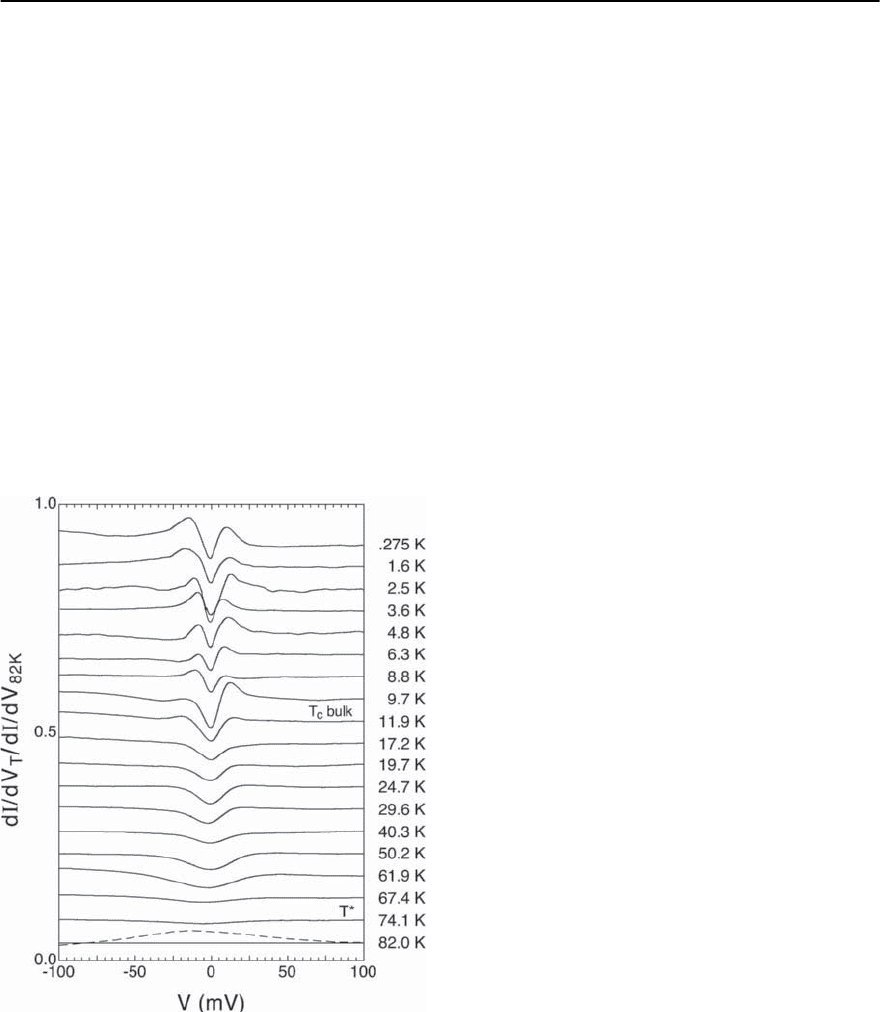
14 High-T
c
Superconductivity 787
quasiparticle excitation spectra, especially in con-
nection with superconductivity [112]. With respect
to the present problem we quote the results of some
recent measurements employing the technique of
scanning tunneling microscopy (STM),providing the
possibility of local tunneling experiments. Informa-
tion about gap features is obtained from measure-
ments of the tunneling current I as a function of
the applied voltage V and by plotting the tunneling
conductance ∂I/∂V versus V. The voltage depen-
dence of the conductance is, to some extent, repre-
senting the energy dependence of D(E
F
), the density
of states for quasiparticle excitations at the Fermi en-
ergy. Early STM experiments [113], again on single
crystals of Bi-2212 compounds, confirmed the pres-
ence of a pseudogap in the normal state, but now
it was claimed that this feature was present for un-
derdoped and overdoped material [114] and that the
temperature dependence of the experimental ∂I/∂V
Fig. 14.32. Temperature dependence of the normalized con-
ductance vs. voltage of overdoped Bi-2201,as measured by
STM.The broken line represents the background at 82 K to
which the curves are normalized. The gap feature persists
to temperatures substantially exceeding T
c
(see [115])
versus V curves was such that the pseudogap had
to be a precursor of the genuine superconducting
gap. More recent experiments on the single Cu-O
layer material Bi-2201 confirmed this view [115]. In
Fig.14.32we show the reported resultsof the temper-
ature evolution of conductance versus voltage curves
for overdoped Bi
2.1
Sr
1.9
CuO
6+d
. It may well be seen
that the reduction of the conductance at low energies
that is believed to indicate a gap feature persists to
temperatures well above the critical temperature of
the bulk. An intimate relation between the two gaps
in either the normal or the superconducting state is
also deduced from the fact that the gap width is more
or less temperature independent [113]. In addition it
has been pointed out that the gap-width variations
from one material to the other is the same for the su-
perconducting and the normal state, again suggest-
ing a common origin of the two features. The data
imply a filling of the gap with increasing tempera-
ture, rather than the commonly expected narrowing.
Aspointedout above,the STM results seem to con-
firm some of the conclusions that are drawn from
the ARPES data but in addition and unlike a number
of other experiments, they claim the persistence of
the normal state pseudogap well into the overdoped
regime.
14.4.2 Superconductivity
General Remarks
The unexpected occurrence of superconductivity in
these cuprate materials at unprecedented high tem-
peratures almost immediately raised questions with
regard to possible mechanisms that might trigger
these transitions. Most researchers would agree that
this issueis not yet definitely settled, as also the theo-
retical chapters of this treatise may demonstrate.The
main controversy addresses the question whether
lattice degrees of freedom are in any way involved in
theoccurrence of superconductivity in copperoxides
or whether this phenomenon is entirely based on in-
teractions within the,however anomalous,electronic
subsystem. Early flux-trapping experiments [116]
made it clear, at least, that the objects responsible for
the superconducting state carry a charge of twice the
charge of a singleelectron,i.e.,2|e|,justastheCooper
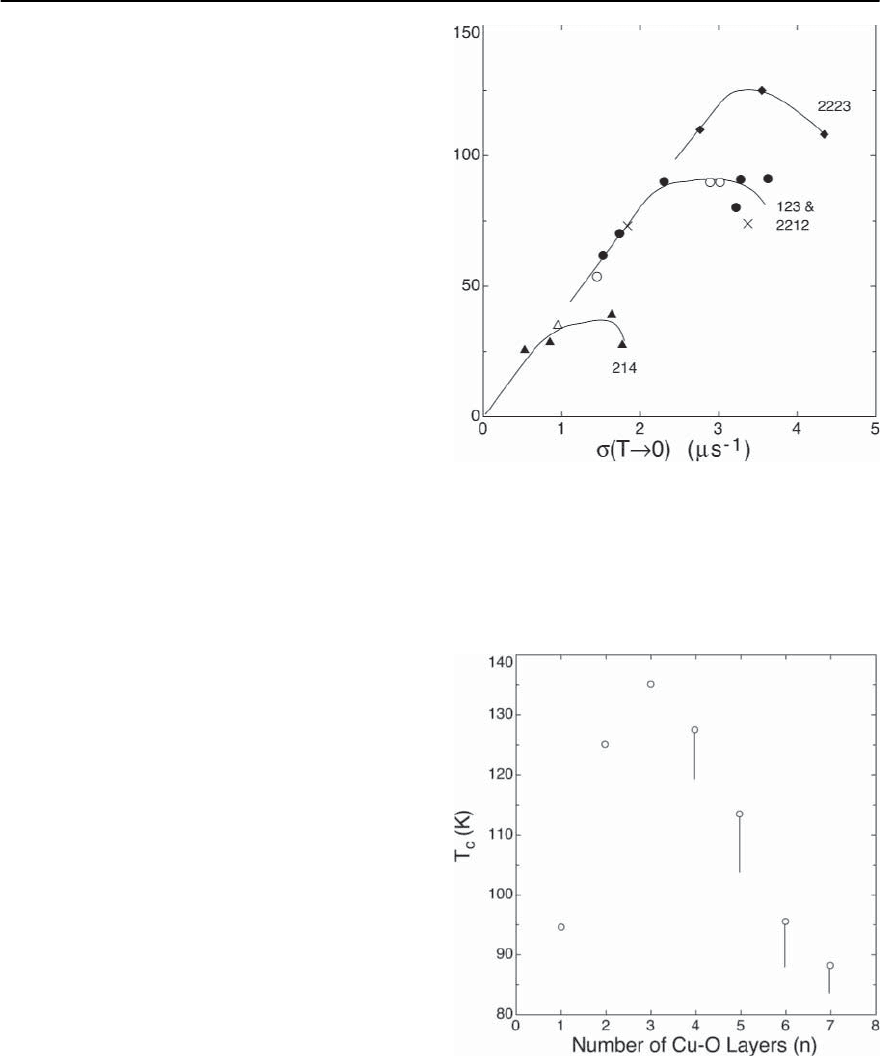
788 H.R.Ott
pairs in conventional superconductors. As has long
been known, of course, pairing states need not be
of the simplest variety with zero orbital momentum
and a spin singlet configuration. Although of little
interest at first, the pairing configuration became an
issue in the wake of some theoretical debates,andwas
finally addressed experimentally by a number of dif-
ferent types of measurements.Another phenomenon
that is intimately related with superconductivityand
is not observed for normal conductors, is the screen-
ing of static external magnetic fields H from the in-
terior of a singly connected superconducting speci-
men, i.e., the decay of H over a characteristic length,
the London penetration depth
L
.Earlyexperiments
using muon-spin rotation (SR) techniques estab-
lished beyond any doubts that also for the cuprate
superconductors this field expulsion, the Meissner–
Ochsenfeld effect, is present [117].
The major difficulty, both in experiment and in
theory, however, is still the unequivocal identifica-
tion of the objects that are to be paired. At least
part of our discussion concerning the normal state
properties have made it clear that these objects are
not yet really well defined. Because of the structural
characteristics of the cuprates and the correspond-
ing anisotropies,alarge part of the discussion of their
superconductivity concentrated on the properties of
the Cu-O planes and the possible influence of the
two-dimensionality of these systems.In what follows
we try to achieve a dense presentation of some of
the most significant aspects concerning supercon-
ductivity in Cu oxide materials, now concentrating
on the characterization of the superconducting state.
A lot of experimental evidence has been accumulated
that the superconductivity of cuprates is of uncon-
ventional nature.Above we have already emphasized
the importance of the concentration n
c
of itinerant
charge carriers, dictated by the degree of doping the
electrically insulating parent compounds and its in-
fluence on the magnitude of the critical tempera-
ture. That the behavior of T
c
(n
c
) is, to some extent,
quite universal,as may be seen in Fig.14.33,has been
pointed out by Uemura[118].Themagnitude of T
c
is,
to a large extent, also dictated by the number n of Cu-
O planes per unit cell.Itturns out that for one class of
materials, T
c
may be enhanced by enhancing n,but
Fig. 14.33. The variation of the critical temperature T
c
of
cuprate superconductors vs the low temperature SR re-
laxation rate .Theclosed and open triangles arefor La-214
compounds, the closed and open circles are for Y-123 ma-
terial, the crosses represent data of Bi-2212 material and
the closed diamonds are for Bi-2223 compounds.The solid
lines are to guide the eye (see [118])
Fig. 14.34. Variation of the critical temperature T
c
of mer-
cury based superconductors HgBa
2
Ca
n−1
Cu
n
O
2n+2+ı
as a
function of n, the number of Cu-O planes (see [39])
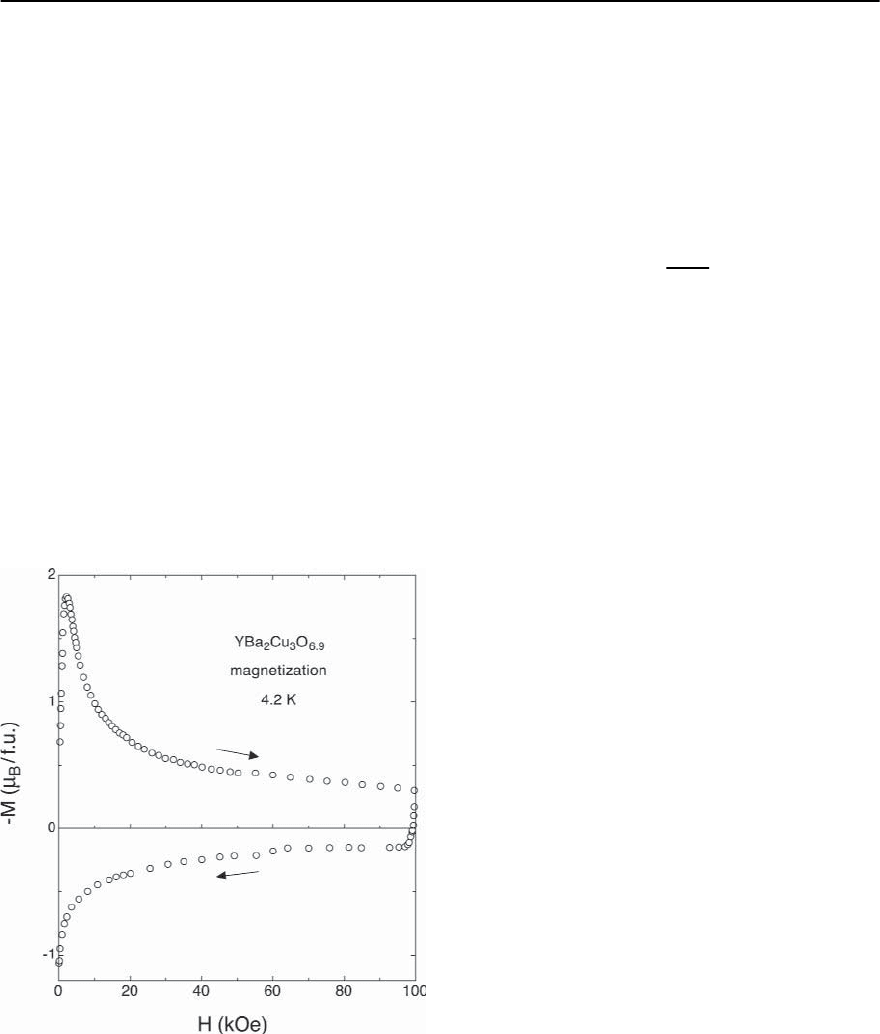
14 High-T
c
Superconductivity 789
this trend is usually only obeyed up to n =3.This
latter trend has very nicely been demonstrated for
Hg-based cuprates,as may be seen in Fig. 14.34 [39].
Inspecting the behavior of electron or hole doped
bulk cuprate superconductors,it seems obvious that
hole doping of insulating cuprates results in signifi-
cantly higher values of T
c
than electron doping. This
naturally forces the question in what way the degree
of the occupation of electronic states contributing
to electronic conduction influences the magnitude
of the critical temperature for the onset of super-
conductivity in general. In this context it is at least
amusing to note that even in the case of supercon-
ductivity of common metal elements most of them
have a normal-state Hall constant with a positive
sign, which is typical for hole dominated conduc-
tivity.Atheoretical model,emphasizing“hole super-
conductivity”, has been promoted by Hirsch and co-
workers [119].
As most non-elemental superconductors, the
cuprates are type II superconductors with extremely
large ratios H
c2
/H
c1
between the upper and the
Fig. 14.35. Negative magnetization of a ceramic sample
of superconducting YBa
2
Cu
3
O
7−ı
as a function of applied
magnetic field up to 100 kOe. The arrows indicate the di-
rection of the field variation
lower critical fields or, in other words, resulting in
a very large value of the Ginzburg–Landau param-
eter = /. This may qualitatively be recognized
from magnetization curves M(H), such as the one
displayed in Fig. 14.35 for YBCO-123 [120]. Taking
into account that by definition
H
c1
=
¥
0
4
L
2
ln (14.7)
and
H
c2
=
¥
0
2
2
, (14.8)
the shape of the curve readily implies that the pen-
etration depth
L
for magnetic fields is much larger
than the superconducting coherence length .For
various reasons, the experimental evaluations of
these critical fields of cuprate superconductors are
not very precise or even impossible.In particular,H
c2
is often regarded as a crossover field only, without
manifesting a true phase transition. Because of these
uncertainties we refrain from presentations and dis-
cussions of critical field data and their temperature
dependence. However, both the magnetic-field pen-
etration depth
L
and the coherence length may be
evaluated with an adequate certainty from M(T, H)
data[121,122].Itturnsoutthatthesetwo characteris-
tic lengths are very anisotropic, of no surprise when
considering the structural properties of these mate-
rials. This also means that the magnitudes of the crit-
ical fields for magnetic-field orientations parallel or
perpendicular to the Cu-O planes are very different.
In most cases, the in-plane components of the two
lengths that are of interest.Since the values for the in-
plane penetration depths are between 1000 and 3000
Å for most of these cuprates [123], it is clear that the
in-plane coherence lengths are of the order of a few
in-plane interatomic distances, i.e., extremely short.
The situation is even more extreme for the direction
perpendicular to the Cu-O plane.Here,
L
may of the
order of a few 10
4
Åand is barely as long as an
out of plane interatomic distance or even less. These
anisotropies, often expressed by the ratio =(m
c
/m
ab
)
1/2
between the effective masses entering the
penetration depth equation, and the short coherence
lengths create a situation that is very different from
that encountered in conventional superconductors
and, as we shall see, provoke special features in some

790 H.R.Ott
of the observations to be discussed below. Because
of the short coherence lengths, the coherence vol-
ume is rather small and may host only a low number
of Cooper pairs. This situation favors large fluctua-
tion effects; their importance is discussed in a special
chapter of this book.
Pressure Effect, Isotope Effect
So far we have only considered T
c
variations induced
by changes of the chemical composition of the mate-
rials. Other external influences, apart from applying
external magnetic fields, that may affect the critical
temperature, are the application of external pressure
or replacing part of the atoms with other isotopes of
the same element. Historically, the strong enhance-
ment of T
c
of the first La-based copper oxide super-
conductors of the 214 family upon applying exter-
nal pressure [124] led eventually to the discovery of
the YBCO-123 superconductor, by following up the
idea that the smaller ionic radius of the Y
3+
ions
might enhance the internal pressure of La
3+
-based
compounds and thus lead to higher critical tempera-
tures [5]. Since the reduction of the volume by exert-
ing external pressure may affect the spectra of both
the lattice and the electronic excitations, direct and
chemical pressure may not always induce equivalent
variations of physical properties. In most common
superconductors, external pressure usually reduces
T
c
and this trend is interpreted as being due to a
pressure induced weakening of the electron phonon
coupling constant
ph
which in essence determines
the magnitude of T
c
of materials where supercon-
ductivity is due to the electron phonon interaction.
It has been shown [125] that to a good approximation
ph
=
A
(MŸ
2
D
)
, (14.9)
whereAisaconstantforagivencrystalstructure,
M is the ionic mass and Ÿ
D
is the Debye tempera-
ture. The pressure induced stiffening of the lattice
and the corresponding enhancement of Ÿ
D
thus ac-
count forthe observed decrease of T
c
with increasing
pressure. Exceptions from this trend of ∂T
c
/∂p < 0
areonlyafew,themostprominentbeingthatofLa
metal where T
c
increases considerably with increas-
ing pressure [126],and always have been considered
as indicating some anomalous pressure response of
the electronic subsystem.Thus,in relation with com-
mon superconductors, the generally negative influ-
ence of external pressure on T
c
is usually interpreted
as confirming the importance of the electron phonon
interaction for triggering the phase transition.
For optimally doped Cu-O superconductors, the
pressure effect on T
c
is, in most cases, negligible.
Prominent exceptions are YBCO-124 and Hg-1223,
the compound with the highest yet achieved criti-
cal temperature under ambient pressure conditions.
An unusually strong enhancement of T
c
from 80 K
at ambient pressure to 108 K at 10 GPa has been re-
ported for the YBCO-124 compound [127] and was
interpreted as being due to a sizeable shortening of
the Cu2-O1 bond, leading to a charge transfer into
the Cu-O planes. Also for Hg-1223, the application
of external pressure raises T
c
considerably.Although
different claims for the T
c
enhancement, up to 160
K at pressures between 150 and 300 kbar, have been
made [128–130], it is undisputed that the pressure
induced enhancement is significant and can appar-
ently not be achieved by means of variations of the
chemical composition. It has been argued that the
three Cu-O planes per unit cell of this compound are
not all optimally doped at ambient pressure and that
the situation can only be improved by a pressure in-
duced transfer of charge carriers between the planes,
not achievable by chemical means. This automati-
cally means that the large positive value of ∂T
c
/∂p is
most likely not a lattice effect and certainly cannot
be used to make a case for a significant influence of
an electron phonon interaction in the creation of a
superconducting state.
Much more clean in regard of identifying the sig-
nificance of lattice effects being involved in the su-
perconductivity of any material is the controlled ex-
change of isotopes of some or all the atoms involved
in the chemical composition of a superconductor,be-
cause the different ionic masses will only affect the
lattice properties of the material. Indeed, measure-
ments of the isotope effect on T
c
gave the first un-
equivocal experimental evidence for the importance
of the lattice dynamics on superconductivity in sim-

14 High-T
c
Superconductivity 791
ple metals [131, 132]. For elements the situation is
particularly simple because
T
c
∼ M
−˛
(14.10)
and in first approximation [133] it is expected that
˛ =1/2. This result has been verified in a number
of cases [134], but deviations from this most simple
behavior, the most drastic for ˛-U, implying neg-
ative values of ˛ [135], have been identified even
for elemental superconductors. The interpretation
of isotope effect experiments is increasingly more
complicated, if the chemical composition of a mate-
rial involves four or more constituents, as is the case
for many high-T
c
superconductors. Nevertheless,the
presence of an isotope effect on T
c
almost inevitably
indicatesthe influence,evenif oflimitedsignificance,
of the crystal lattice on the mechanism triggeringthe
superconductivity.
Reliable results on the isotope effect on T
c
of
cuprates are difficult to achieve.This is because apart
from exchanging the chosen isotope,anyother varia-
tionsin the composition ofthematerial and its struc-
tural properties must be avoided. In copper oxide
compounds, the element of choice for a controlled
isotope exchange is, of course, oxygen. Careful work
in exchanging
16
Owith
18
O and back has been made
on La
2−x
Sr
x
CuO
4
with 0.1 ≤ x ≤ 0.15 [136]. From
these experiments it is concluded that the compound
with
18
O exhibitsa distinctlylower T
c
than if the oxy-
genation is accomplished with
16
O. While the anal-
ysis of the measurements indicates that there is no
isotope effect on the charge carrier concentration, as
one might expect, a significant shift of the effective
mass of the carriers, which are identified as being of
polaronic character, is deduced. Since similar results
have been obtained in a number of other analogous
investigations [137, 138], it has to be accepted that
at least in some of the high-T
c
superconductors, the
isotope effect is not negligible.
More recently it has been claimed that iso-
tope variations are also affecting the onset tem-
perature T
∗
of the pseudogap formation discussed
above. The corresponding experiments involved the
measurements of linewidths of crystal field exci-
tations probed by inelastic neutron scattering on
HoBa
2
Cu
4
O
8
[139]. While the isotope effect on the
critical temperature is, in accordance with other
work, found to be rather small with ˛ ≈ 0.05,
the variation of T
∗
with the exchange of
16
Oand
18
O is considerable and of opposite sign, i.e., T
∗
of
the
18
O variety of the compound is distinctly higher
than T
∗
of the
16
O material. The corresponding ˛
parameter in T
∗
∼ M
−˛
is therefore negative. This
again seems to indicate that the lattice dynamics are,
to a certain extent, involved in the formation of the
pseudogap of the normal state. It may well be that
understanding the significanceof the sign difference
in the ˛ parameters for T
c
and T
∗
will also clar-
ify the relation between the pseudogap of the nor-
mal state and superconductivity below T
c
.Inviewof
these experimental results it seems difficult to deny
that superconductivity in copper oxides involves, to
some extent, the lattice dynamics of these materials.
In this regard it has been argued [140] that these
lattice dynamics lead to structural inhomogeneities
in these materials, better known under the names of
phase separation and stripe formation. Microscopic
evidence for stripe formation in some of these ma-
terials has definitely been obtained [141, 142], but
it is not yet clear to what extent this phenomenon
is essential for the occurrence of superconductivity
at elevated temperatures. In interpreting experimen-
tal data obtained with different techniques it should
be kept in mind that the process of stripe forma-
tion may also be highly dynamical in the sense that
the structural inhomogeneities are not static. This
might explain some controversies that arise in com-
paring experimental data from measurements that
probe in different energy or time windows. It seems
clear that structural inhomogeneities will also gen-
erate electronic inhomogeneities and it has not yet
been worked out how these have to be taken into
account in the interpretation of some of the anoma-
lous features of the normal state properties discussed
above.
Phase Transition Asp ects
The short coherence lengths, even within the Cu-O
planes, of the cuprate superconductors, play an es-
sential role in all experimental verifications of the
superconducting phase transition. This is mainly be-
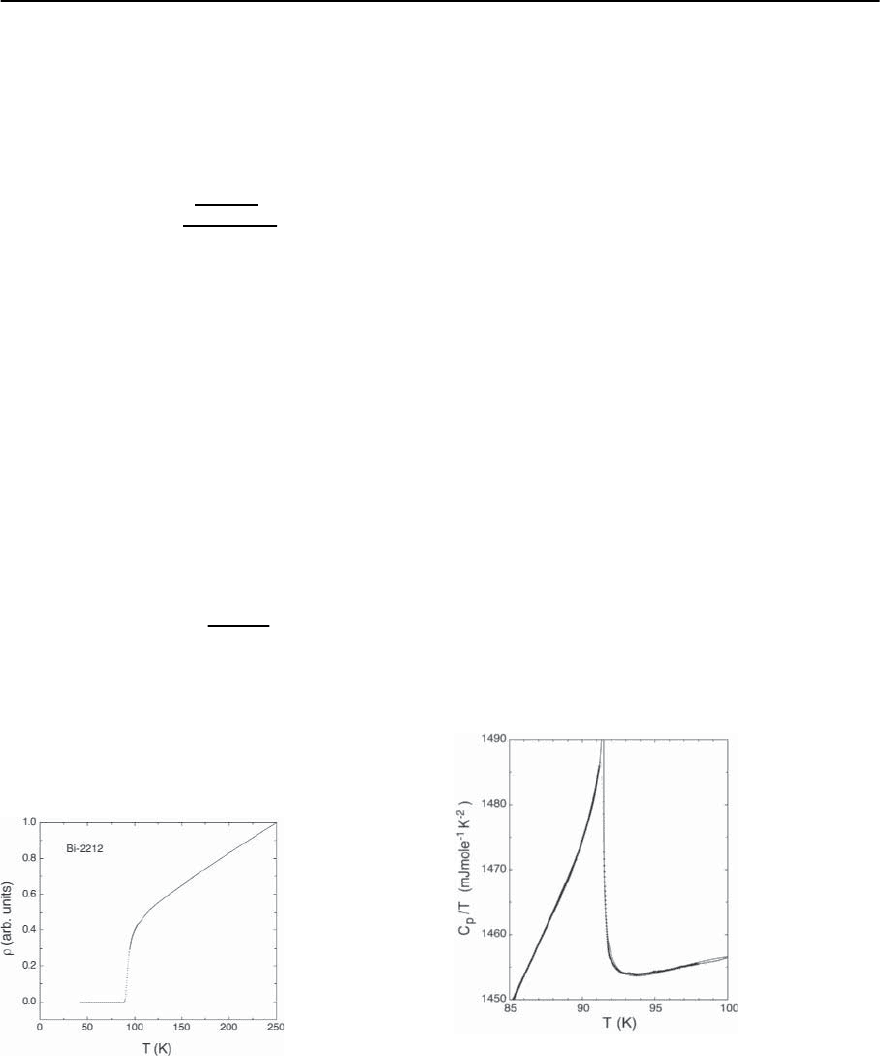
792 H.R.Ott
cause even in zero magnetic field,fluctuation effects
are non negligible to an extent that distinct devia-
tions from the mean field behavior,usually observed
for clean common superconductors, are observed.
The fundamental parameter governing the strength
of these fluctuationsis the Ginzburg number [143]
Gi =
T
c
H
2
c
(0)
2
ab
c
2
2
, (14.11)
where
ab
and
c
are the zero temperature coher-
ence lengths parallel and perpendicular to the Cu-
O planes, respectively. This number, which is obvi-
ously large if the values are small, fixes the temper-
ature range around the critical temperature where
fluctuation effects are significant, i.e., critical, via
|T − T
c
| < T
c
·Gi. For common superconductors,
Gi is of the order of 10
−6
or less and therefore, de-
viations from mean field behavior are usually not
important. The situation is completely different in
cuprates and further complications arise,because of
quasi two-dimensional fluctuation effects in partic-
ularly anisotropic cuprate systems. In that case the
relevant Ginzburg number is [143]
Gi
2D
=
T
c
√
2 · "d
, (14.12)
where " =(¥
0
/4)
2
and d is the thickness of one
layer. Fluctuation effects in the temperature depen-
dences of the electrical resistivity (T) and the mag-
netization M(T) are somewhat annoying because
they mainly hamper an exact evaluation of the zero
field critical temperature. In Fig. 14.36 we show an
Fig. 14.36. Temperature dependence of the electrical re-
sistivity of Bi-2212. Note the growing slope of ∂/∂T far
above T
c
example of (T) of Bi-2212 which demonstrates the
gradual decrease of above T
c
.Athoroughdiscus-
sion of fluctuation effects on the electrical trans-
port is beyond the scope of this more general re-
view. Instead we briefly consider the temperature
dependence of the specific heat C(T)inzeromag-
netic field and in the vicinityof T
c
.As an example we
first present the result of a relevant experiment on
single crystalline YBCO-123 in Fig. 14.37, revealing
the anomaly in C(T) at the transition [144]. As may
be seen from the scale on the left vertical border of
the figure, this anomaly rides on a large background
which at temperatures above the boilingpoint of liq-
uid nitrogen, is due to the specific heat of the lattice.
In order to achieve the experimental resolution that
is demonstrated here and which is necessary to ob-
tainany reliablecomparison withtheoretical models,
special methods of measurement have to be involved.
One particular approach,a differential thermal anal-
ysis (DTA) adapted for measurements on small sin-
gle crystals,is described in [145].Fromthe data close
to T
c
both in the normal and the superconducting
state, clear deviations from ideal mean field behav-
ior may be recognized.The solid line in Fig. 14.37 is
a fit on the basis of the 3D XY model for phase tran-
sitions [146]. A detailed discussion of the relevance
of this model with respect to the critical regime of
the zero field phase transition of cuprate supercon-
Fig. 14.37. Specific heat anomaly at the superconducting
transition of single crystalline YBa
2
Cu
3
O
7−ı
in zero mag-
netic field.The solid line is a fit based on the 3D XY model,
as explained in the text

14 High-T
c
Superconductivity 793
ductors has been given in [147]. Here we only note
that the experimental data can reasonably well be
described on the basis of this model. The analysis is
by no means straightforward. The universal temper-
ature dependence C(T)isgivenby
C(T)=C
lattice
(T)+C + A
−
ln |
T
T
c
−1|,
forT < T
c
= C
lattice
(T)+A
+
ln |
T
T
c
−1|,
forT > T
c
. (14.13)
The parametersA
+
andA
−
are related via the univer-
sal ratio A
+
/A
−
∼
=
1.05. First of all, the lattice part
of the specific heat has to be evaluated with some
degree of confidence. This can be achieved by ad-
ditional measurements in external magnetic fields.
Second it has to be tested to what extent the values of
the fit parameters depend on the temperature win-
dow chosen for the fits.In the case presented here,the
fit quality suggests that the critical regime appears to
be extended over a range of ±8KaroundT
c
.Without
going into further details, we note that attempts with
fits on the basis of other approaches for dealing with
fluctuations in the critical region around T
c
gave less
convincing results.
As may be expected, the specific heat anomaly
is considerably reduced upon the application of an
external magnetic field. This is demonstrated in
Fig. 14.38, where C(T, H) data, measured on the
sameYBCO-123 sample in various external magnetic
fields, oriented perpendicularly to the Cu-O planes,
are displayed.In viewof the success in describingthe
critical fluctuations on the basis of the 3D XY model
in zero field, it seems justified to test a related scal-
ing law that is inherent in this model for non zero
magnetic fields. The relevant scaling relation is
[
C(T, H)−C(T, 0)
]
H
˛
2
= C
T
T
c
−1
H
−1
2
,
(14.14)
where C(x) is the unknown scaling function [148].
The parameters ˛ ∼0.007 and ∼ 0.669 are the 3D
XY criticalexponents of the specific heat and the co-
herence length,respectively.In Fig.14.39,this scaling
is tested by plotting the appropriately scaled quanti-
Fig. 14.38. Influence of external magnetic fields on the spe-
cific heat anomaly at the superconducting phase transition
of single crystalline YBa
2
Cu
3
O
7−ı
Fig. 14.39. Specific heat anomalies of YBa
2
Cu
3
O
7−ı
plotted
in variables that are consistent with 3D XY-scaling (see
Eq. (14.14)). B =
0
H
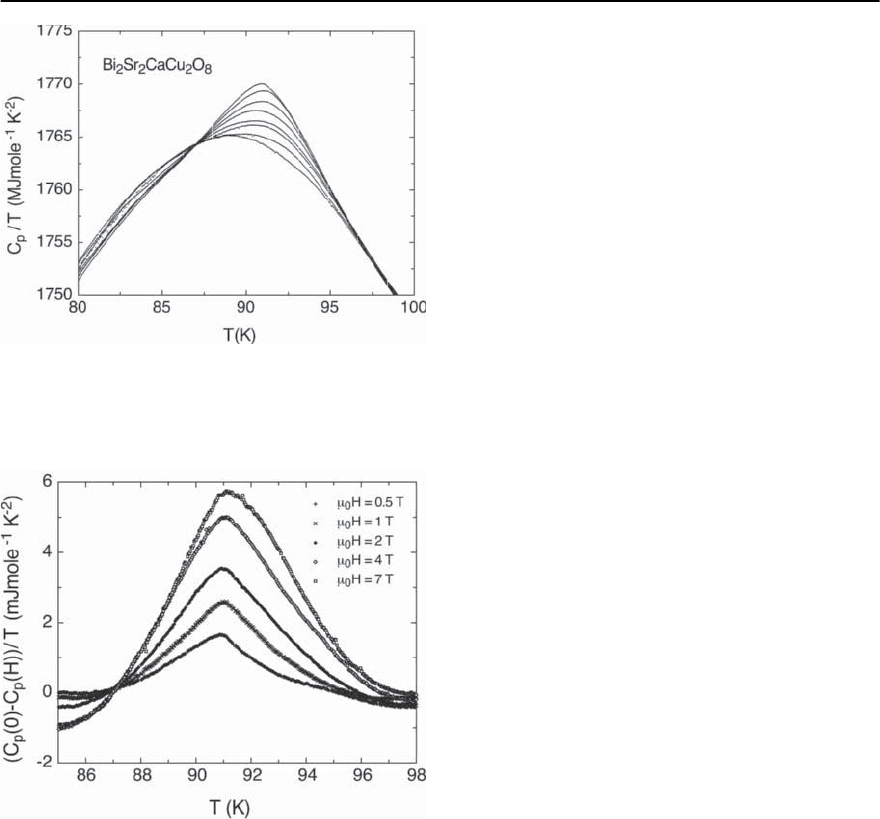
794 H.R.Ott
Fig. 14.40. Specific heat of textured Bi
2
Sr
2
CaCu
2
O
8
in the
temperature range around T
c
= 91 K in different magnetic
fields.The plots C
p
(T)/T are for
0
H =0, 0.1, 0.5, 1, 2, 3, 4
and 7T from top to bottom. Note the crossing point of all
the curves at T ≈ 87 K
Fig. 14.41. Magnetic field dependence of the specific heat
anomalyof superconducting Bi-2212if plottedin the form
[C
p
(0) − C
p
(H)]/T
ties.It may be seen,that the scaling is not well obeyed,
indicating that the use of the 3D XY model for de-
scribing thecritical fluctuationsin external magnetic
fields exceeding 1 T,is inappropriate.Results of other
measurements on other single crystals of YBCO-123
are in conflict with this conclusion,claiming a 3D XY
type scaling to be valid in fields up to 14 T [149,150].
Our second example is C(T) of a Bi-based copper
oxide materialwhoseanisotropyis farmoreexcessive
than that of YBCO-123.For the latter, the anisotropy
parameter is estimated to be less than 10; for su-
perconducting Bi-2212, ∼ 350. In that case it may
be expected that fluctuation effects are drastically
influencing the temperature dependence of the spe-
cific heat in the vicinity of the transition. That this
is indeed the case may be seen in Fig. 14.40, where
C(T, H) of Bi-2212 is shown for a set of different
fields H. Even in zero external field no trace of a dis-
continuity at T
c
,still discernible in the zero field data
of YBCO-123, may be recognized. More instructive
is the plot of [C(0) − C(H)]/T versus T,shownin
Fig. 14.41. It may be seen that the anomaly adopts
the shape of a triangle whose apex is, amazingly,
not shifted in temperature with increasing magnetic
field. These data cannot be brought into agreement
with predictions of the 3D XY model [150,151].
From our brief description of specific heat data of
two typical cuprate superconductors with very sim-
ilar critical temperatures but differing a lot with re-
spect to their anisotropy, it is clear that the char-
acter of the phase transition depends very strongly
on the anisotropy parameter . For small values of
, i.e., less than 10, the phase transition seems, at
least in zero magnetic field, to belong to the 3D XY
universality class. This is certainly not the case for
strongly anisotropic, quasi-2D superconductors. Un-
fortunately, YBCO-123 is probably the only cuprate
superconductor with a low value of ;mostofthe
others are far more anisotropic. It has been argued
that this trend might indicate that in the quasi-2D
systems, the bosonic pairs are preformed and simply
condense at T
c
,thus implying an altogether different
universality class of the phase transition.
The characteristics of the phase transition may
also be discussed on the basis of magnetiza-
tion M(T, H) data. A particularly intriguing phe-
nomenon has been observed in M(T, H)ofcuprate
superconductors with a large anisotropy parameter
. A data set of the temperature dependence of the
magnetization of a single crystal of Bi-2212, mea-
sured in different external magnetic fields [152], is
shown in Fig. 14.42. It may be seen that the M(T, H)
curves all cross in a single point at a temperature
T
cr
< T
c
,implying that the magnetization is field in-
dependent at this single temperature T
cr
.Inpractice
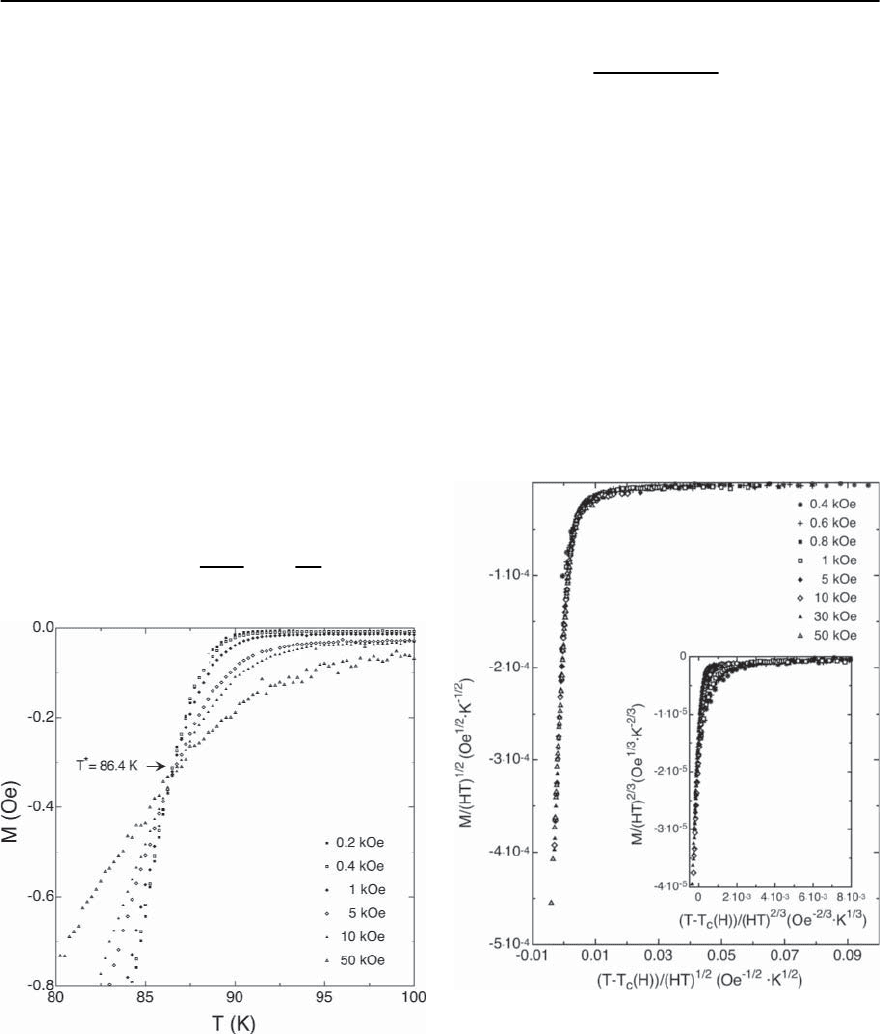
14 High-T
c
Superconductivity 795
it is found that T
cr
is always a few degrees below the
zero field T
c
.The same phenomenon is also observed
for Bi-2201 [153], another extremely anisotropic su-
perconductor, but not for YBCO-123. This crossing
feature indicates that the field dependence of the
magnetization ∂M/∂H changes sign at T
cr
,certainly
not expected for the usual magnetization of a super-
conductor in the mixed state. The sign change may
be understood, however, by considering two contri-
butions to the magnetization, such that
M = M
0
+ M
fl
, (14.15)
where M
0
is the usual field dependent magnetization
of the mixed state, calculated using a modified Lon-
donequationwiththeappropriateapproximations,
and M
fl
is due to thermal fluctuations of the vortices
belowT
c
[154].Usinga modifiedLondon model,also
M
fl
(T) has been calculated with different approxi-
mations in high and low fields. Inserting the appro-
priate expressions forM
0
and M
fl
into Eq.(14.15)and
setting ∂M/∂lnH ≡ 0, one obtains
M
cr
≡ M(T
cr
)=−
k
B
T
cr
¥
0
s
ln
˛
√
e
(14.16)
Fig. 14.42. Temperature dependence of the magnetization
of single crystalline Bi-2212 in the range of the supercon-
ducting transition temperature in various external mag-
netic fields. Note the crossing of all curves at T
∗
=86.4K
and
T
cr
=
¥
2
0
s
32k
B
2
2
ab
(T
cr
)
, (14.17)
where k
B
is the Boltzmann constant and s is taken as
the interlayer distance, which is of the order of 1 nm.
The numerical values of and ˛ are not easy to eval-
uate andoften it is assumed that ln(˛/
√
e) = 1 [155].
Forthisreasonitisdifficulttocheckthequantitative
agreement between the experimental and calculated
values of M
cr
and T
cr
.
The crossing of the M(T, H)curvesatasingle
temperature, experimentally observed to occur in an
unexpectedly wide range of magnetic fields [152],
indicates that some scaling should be obeyed. This
is indeed the case, as may be seen in Fig. 14.43.
The analysis is based on scaling functions that have
been deduced from a Ginzburg–Landau free en-
ergy functional for quasi-2D type II superconduc-
Fig. 14.43. Scaling of the magnetization of Bi-2212at differ-
ent temperatures and in different magnetic fields.The scal-
ing variables of the main frame are from a 2D Ginzburg–
Landau, lowest Landau level (GL–LLL) type approxima-
tion. In the inset,the same data are plotted assuming a 3D
version of the GL–LLL scaling (see text)
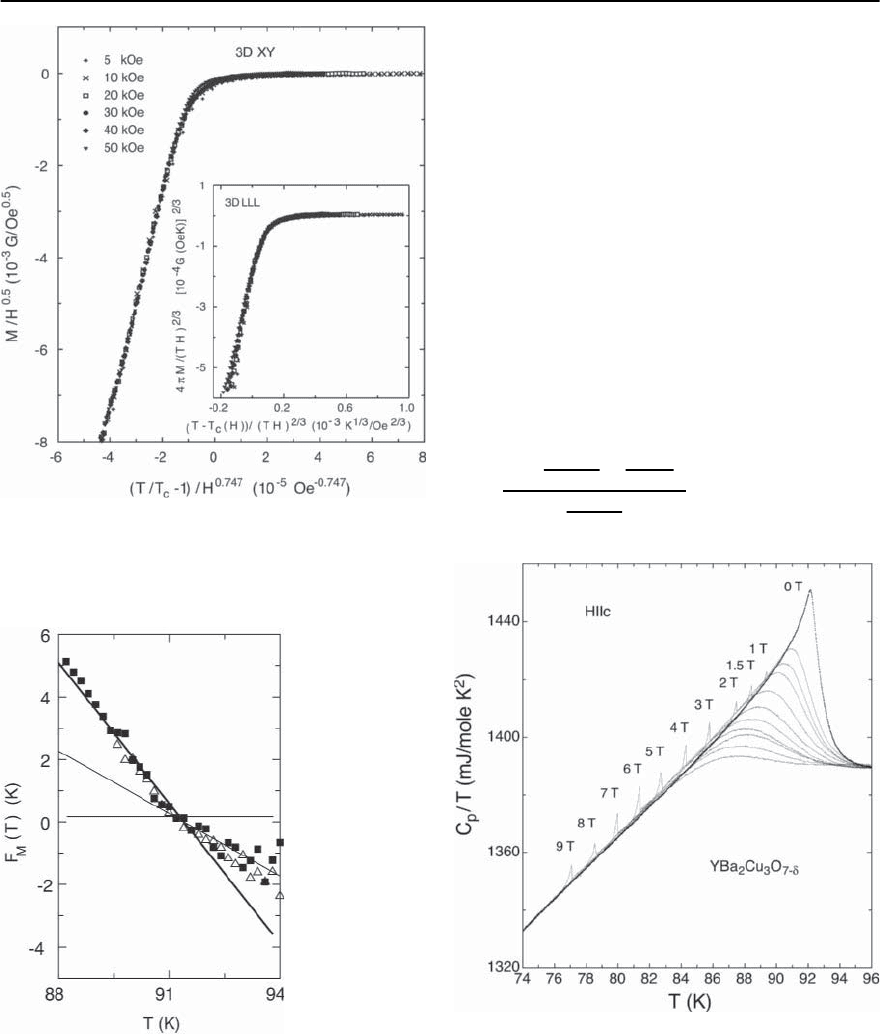
796 H.R.Ott
Fig. 14.44. Scaling of the magnetization of Y-123. The scal-
ing variables in the main frame are compatible with the 3D
XY model while those in the inset are consistent with 3D
GL-LLL scaling
Fig. 14.45. F
M
(T), as defined in Eq. (14.18), vs T. Open tri-
angles:
0
H =0.75 T. Full squares,
0
H = 15 T. The plot
indicates that the critical exponent is not the same above
and below T
c
(see text)
tors [155]. In this case, the scaling function variable
is [T − T
c
(H)]/(TH)
1/2
. The corresponding plot of
the renormalized magnetization in Fig.14.43 reveals
that the scaling, based on fluctuations in two dimen-
sions,is rather well obeyed.In addition,the same plot
for 3D scaling, shown in the inset of Fig. 14.43, im-
plies that the corresponding approach is not valid
in this case. A 3D scaling of this same type has,
however, been verified [156] for analogous data of
YBCO-123 where, as mentioned above, the crossing
phenomenon is absent. A scaling plot, based on the
scaling variable valid for the 3D situation is shown in
Fig. 14.44.
Another possibility for checking the scaling of
M(T, H) in the critical regime is offered in the fol-
lowing way. The unknown scaling function may be
eliminated by evaluating
F
M
=
2H
∂M(T,H)
∂H
−
M(T,H)
2H
∂M(T,H)
∂T
≡ (T
c
− T)/ , (14.18)
Fig. 14.46. Temperature dependence of the specific heat of
single crystallineY-123 in various external magnetic fields
oriented along the orthorhombic c-axis. Note the sharp
anomalies at decreasing transition temperatures upon in-
creasing magnetic field (see [162])
